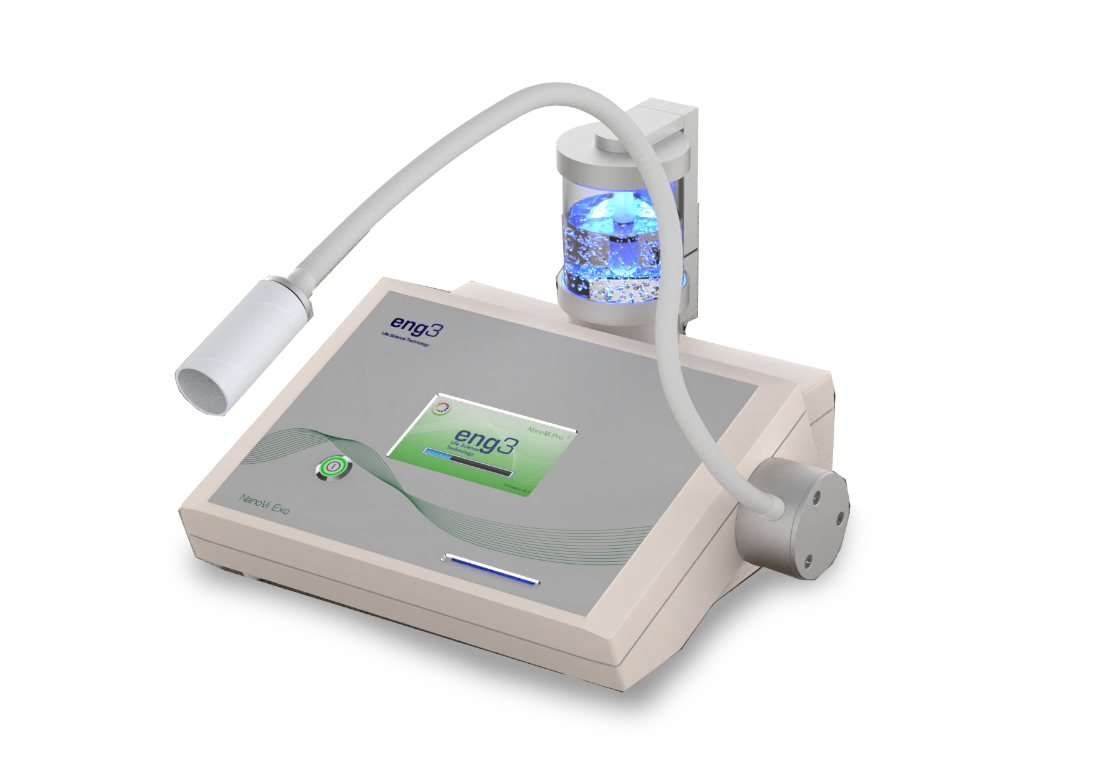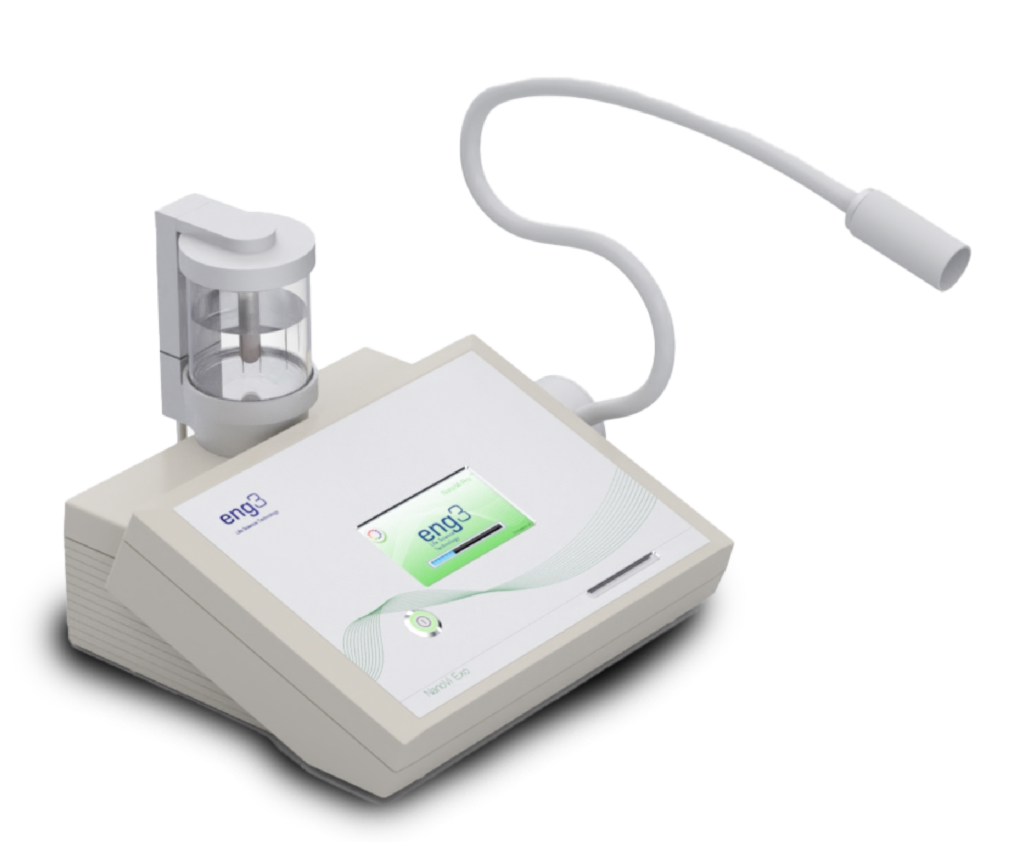The scientific article “Effect of Humid Air Exposed to IR Radiation on Enzyme Activity” considers the impact of NanoVi® on damaged proteins
A study on the impact of NanoVi® on damaged proteins was recently published in the International Journal of Molecular Sciences. This scientific journal is peer-reviewed and highly ranked for being impactful in the scientific community. The purpose of the study was to investigate the ability of NanoVi to affect the activity of proteins when they were exposed to damaging factors including heat, oxidation, and chemical denaturants.
Researchers refer to the output from NanoVi as coherent humidity or CoHu because NanoVi has been proven to initiate coherence in the water droplets. NanoVi does this by exposing the humid airstream to specific wavelengths of infrared radiation (IR), which explains the use of this phrase in the title.
Three different proteins, all of them enzymes, were studied for each type of damage. In addition, treatment before and treatment after damage was studied. This means researchers investigated six different results for each of three types of damage. In total, there are 18 outcomes reported in this scientific article – too many to reiterate in this context. Some highlights are presented here, along with basic information about how the study was conducted.
Proteins studied
This research focuses on three proteins. All are enzymes, which means they catalyze biochemical reactions in the body. Each type of protein studied plays important and complex roles in the body, so the brief descriptions below only give you a glimpse of what they do.
- Alkaline phosphatase – helps fight off bad bacteria in the gut, maintains strong bones and supports neurogenesis to keep your mind sharp
- Peroxidase – breaks down peroxides that otherwise induce oxidative damage and accelerate aging
- Catalase – protects the cell from oxidative damage by catalyzing the decomposition of hydrogen peroxide into water and oxygen.
Controls and testing
Controls allowed researchers to accurately evaluate the impact of NanoVi. Two of the controls treated samples with an inactivated device. The only difference was that the IR irradiation units inside were switched off. This allowed researchers to be certain that it was NanoVi’s patented technology that made the difference.
Each test had the following controls:
- Undamaged control – grey line (not always shown)
- Damaged control – red line
- Inactivated device applied before damage – yellow line
- Inactivated device applied after damage – blue line
The various controls allowed researchers to determine, how much protein activity remained after each damaging event and how much of it could be recovered with or without NanoVi. To make the graph more readable, the undamaged control (grey line) is not always shown. Research methods and materials are described in detail by the authors and not repeated here.
Results
Heat damage
Samples treated with NanoVi either before or after head damage showed higher activity (better recovery) than the rest of the samples.
Compared to the inactivated control, the average increases in peroxidase activity was 25% more when samples were treated with NanoVi prior to inactivation and 15% more when treated after. Treatment of the enzyme before inactivation had a stronger effect than after, which suggests that NanoVi may have protective effect on heat-damaged peroxidase. These results are shown in the graph on the left.

Heat damaged peroxidase

Heat damaged alkaline phosphatase
On the right are results for heat damage to alkaline phosphatase. The NanoVi treatment after damage showed significant improvement, the average increase in activity was 30% more than the damaged control. Notice that unlike peroxidase, pretreating alkaline phosphatase was not helpful for heat damage.
Treatment with NanoVi both before and after heat inactivation helped restore the catalytic functions of catalase. Treatment before damage showed an 18% increase compared to the damaged control while treatment after had a 13.4% increase.
The NanoVi device appeared to have a stabilizing or preventative effect on both peroxidase and catalase. Protein stability has important implications for wellbeing, as noted by the authors:
“Protein stability is one of the parameters that allow cells to withstand oxidative stress and premature aging.”
Oxidative damage
When proteins were oxidized, the recovery with NanoVi was even more remarkable than recovery from heat damage. Only about 11% of the peroxidase enzymes remained active after they were damaged with oxidation. Peroxidase samples treated with the NanoVi device prior to damage restored activity to 45% and those treated after damage recovered 42% of the undamaged control. These increases in activity were 35% and 32% more than the damaged control and are shown on the left below.

Oxidized peroxidase

Oxidized alkaline phosphatase
The graph on the right shows that treatment with NanoVi after alkaline phosphatase was oxidized helped to restore 19.8% of the intact enzyme activity (more than three times the oxidized control). Treatment before oxidation partially protected the protein and saved an average of 18.1% of intact activity. For the enzyme Catalase, only treatment after oxidation showed a statistically significant benefit when compared to the untreated control.
The evidence of faster recovery from oxidative damage with NanoVi is significant. Oxidation is not only implicated in chronic diseases, it also plays a fundamental role in aging. According to the authors:
“Protein oxidation is a well-known reason for aging. As proteins are responsible for managing a vast number of cell functions, their oxidation leads to a gradual accumulation of faults and cellular failures… Oxidation of a protein leads to the formation of chemical radicals within amino acids themselves and increases the chance of structural deformation.”
Chemical damage
Researchers considered whether treatment with NanoVi could partially restore the activity of denatured proteins. A chemical denaturant was used to damage proteins by causing them to unfold.
For peroxidase, a restoring effect was observed in response to the use of NanoVi both before and after unfolding. 32% of the peroxidase survived the damaging event. Treatment before proteins were denatured increased their activity to 53% which was 66% more than the denatured control. NanoVi treatment after damage showed even better results, up to 61% of intact enzyme activity was restored. This was 89% more than the denatured control. For peroxidase, treatment after proteins were denatured had a greater impact, as shown below on the left.

Chemically damaged peroxidase

Chemically damaged alkaline phosphatase
When the unfolding agent was applied to alkaline phosphatase, activity was reduced to 24% of the undamaged control, shown above on the right. Treatment with NanoVi after unfolding helped restore some of the enzyme activity increasing it to 36%, which is one and a half times the unfolded control. Treatment before damage had no significant effect.
For catalase, there is a significant effect when treatment with NanoVi happens after denaturation. Treatment before damage did not show significant increase in activity, compared to the controls.
NanoVi approach
An important aspect of this study is the proteins were not irradiated directly, rather they were treated with humidified air that had been irradiated. The NanoVi device uses humidity as an intermediary, which has several advantages including:
- irradiation with IR heats liquid water while microdroplets in the air lose heat faster
- water microdroplets have an exclusion zone water layer on their surface, and their total surface area is much larger than the surface area of liquid water
- water droplets absorb IR energy more intensely than liquid water
- irradiation of microdroplets causes them to oscillate coherently and create coherent domains (CDs), irradiating liquid water is less effective at creating CDs.
Authors suggested that the beneficial effects they observed resulted from altering the physicochemical properties of water with the coherent humidity from NanoVi.
Read the PubMed abstract, or access the full International Journal of Molecular Sciences article.
If you’d like to learn more about the NanoVi device, its proven benefits, and the price, sign in below.
Eng3 will send you an email as soon as you submit the form, please check your spam filter if you don’t receive it. We only send study results and other valuable information. Your email will not be shared or flooded with promotional content.
rev01





